Hi Guys,
Hope your all well amidst this awful pandemic..
Now to speaker related stuff..
On Lockdown here and I am designing some boxes to be used with a pair of 8CX21s. Just ordered a pair from BluAran with XO-1s... I thought I would try my best to achieve doing so with HORNRESP, for the first time.
My specification so far is to have a speaker that will play low enough without sacrificing Xmax + Output, a typical conundrum.
I have a single 12 to take over the rest.
The 8CX21 as per its own specification is useful around 80Hz+
I originally started in WINISD but then decided to move over to Hornresp as now is the right time to break the cherry.
Here is a rough CAD design of the box to give you an idea..
Internal Volume 13Litres
Circular Port W-50mm L-230mm
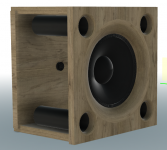
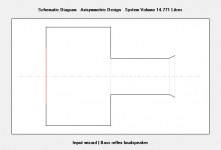
Here is the response at rated speaker wattage HPF24LW75hz+LPF (200w)
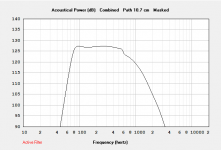
Here are the parameters
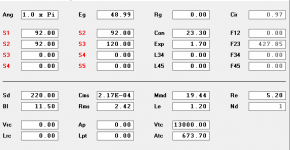
Here are a couple of amateur observations.
First of all is the displacement, which to me looks unhealthy.. This can be changed to a more appropriate value by shortening the ports but ultimately changes the response to peak around 100hz quite nastily. I am presuming from this data that I won't get the most out of this drivers output.
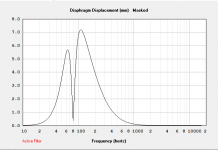
The second is the air velocity, This is after adding the exponential taper (S3) measured from the horn mouth. I have heard the magic 17m/s rule of course but is a few more m/s going to be heard as chuffing at these levels anyway?
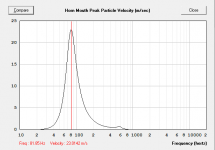
If anyone wants to go over what I have done and point out any errors or ask any questions, please fire away. Again it's a first time using horn response and I am hoping I have used it correctly.
Kind Regards
Dec
Hope your all well amidst this awful pandemic..
Now to speaker related stuff..
On Lockdown here and I am designing some boxes to be used with a pair of 8CX21s. Just ordered a pair from BluAran with XO-1s... I thought I would try my best to achieve doing so with HORNRESP, for the first time.
My specification so far is to have a speaker that will play low enough without sacrificing Xmax + Output, a typical conundrum.
I have a single 12 to take over the rest.
The 8CX21 as per its own specification is useful around 80Hz+
I originally started in WINISD but then decided to move over to Hornresp as now is the right time to break the cherry.
Here is a rough CAD design of the box to give you an idea..
Internal Volume 13Litres
Circular Port W-50mm L-230mm


Here is the response at rated speaker wattage HPF24LW75hz+LPF (200w)

Here are the parameters

Here are a couple of amateur observations.
First of all is the displacement, which to me looks unhealthy.. This can be changed to a more appropriate value by shortening the ports but ultimately changes the response to peak around 100hz quite nastily. I am presuming from this data that I won't get the most out of this drivers output.

The second is the air velocity, This is after adding the exponential taper (S3) measured from the horn mouth. I have heard the magic 17m/s rule of course but is a few more m/s going to be heard as chuffing at these levels anyway?

If anyone wants to go over what I have done and point out any errors or ask any questions, please fire away. Again it's a first time using horn response and I am hoping I have used it correctly.
Kind Regards
Dec
Some notes:
- Make sure you model with the intended crossover filter - that'll directly affect the port velocity and excursion.
- The port velocity and excursion shown in the graphs are reached when you input a 49V sine tone at that frequency. For a cabinet like yours, that's going to happen very rarely - such things don't really happen to mid-high speakers.
For subwoofers, however, that can be a much larger concern. Subwoofers typically only reproduce an octave or two, so they're very likely to receive large power inputs at the worst-case frequency.
- You might want to think about standing waves within a cabinet that looks approximately square
- Your ports are quite close to the back wall and corners, so you might find the tuning comes out lower than you want it.
Apart from those last two concerns, it looks like your design work is fine.
Modern ProSound coaxials can sound very very good.
Best of luck!
Chris
- Make sure you model with the intended crossover filter - that'll directly affect the port velocity and excursion.
- The port velocity and excursion shown in the graphs are reached when you input a 49V sine tone at that frequency. For a cabinet like yours, that's going to happen very rarely - such things don't really happen to mid-high speakers.
For subwoofers, however, that can be a much larger concern. Subwoofers typically only reproduce an octave or two, so they're very likely to receive large power inputs at the worst-case frequency.
- You might want to think about standing waves within a cabinet that looks approximately square
- Your ports are quite close to the back wall and corners, so you might find the tuning comes out lower than you want it.
Apart from those last two concerns, it looks like your design work is fine.
Modern ProSound coaxials can sound very very good.
Best of luck!
Chris
Some notes:
- Make sure you model with the intended crossover filter - that'll directly affect the port velocity and excursion.
- The port velocity and excursion shown in the graphs are reached when you input a 49V sine tone at that frequency. For a cabinet like yours, that's going to happen very rarely - such things don't really happen to mid-high speakers.
For subwoofers, however, that can be a much larger concern. Subwoofers typically only reproduce an octave or two, so they're very likely to receive large power inputs at the worst-case frequency.
- You might want to think about standing waves within a cabinet that looks approximately square
- Your ports are quite close to the back wall and corners, so you might find the tuning comes out lower than you want it.
Apart from those last two concerns, it looks like your design work is fine.
Modern ProSound coaxials can sound very very good.
Best of luck!
Chris
Hi Chris, I just lost my whole reply to you, extremely frustrating.. I went into detail and lost it so I'm gonna be a bit quicker with my response... thanks for your reply anyway.
Basically.. I have a more updated picture of the enclosure showing the port arrangement below in regards to wall proximity..
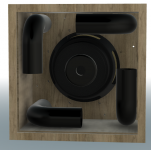
As for the Crossover... i'm pretty sure it's only crossing at 2KHz. Either way I have placed a HPF at around 75Hz to disregard sub frequencies that affect the max displacement.
The 49V was to simulate 50% peak response at around 300W.. I think that is appropriate considering the drivers rating for 400W.. Correct me if I am wrong.
As for standing waves, given the box dimensions there are two main peaks at around 600hz, given the box is 30cm wide.. as for the depth being 19cm that would exceed being heard from the port. Especially considering the internal dampening etc.. Again, please correct me if I am being naïve.
I wanted to ask, for the port cross sectional area.. is that correlating as S1 & 2? does that mean 50mm wide port equals 19.63cm2 and because I have 4 ports on the enclosure I need to X area2 by 4 giving me 78.5 to place into S1 and S2 to define the port cross section? that also goes for the additional flare on each port totalled.
As for the chamber dimensions.. from what I understand in the screenshot below my chamber is 13Litres at a depth of 19.3cm. What baffles me is how to translate that into a chamber geometry from the picture.. can it be (within reason) ANY shape as long as I adjust XYZ until I achieve 13L excluding volume taken up by the ports and the driver.
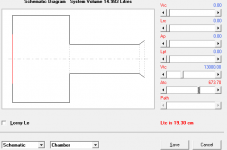
Sorry for all the questions, first time i'm starting to understand Hornresp and I just wanted to check that my thinking/theory is correct.
Kind Regs
Dec
Hi Dec,
Even though your schematic diagram says "Input Wizard | Bass reflex loudspeaker", the system you show is not actually the one that the input wizard produces. Ideally you should be using the configuration generated by the input wizard, which automatically includes an internal end correction on the port tube. Because you have specified the port tube using a horn segment instead, a length correction is not included at the throat end (unless you manually add it to the segment length). Also, you have specified stepped segments, which are not necessary with your design.
The equivalent system to yours, generated using the input wizard, is as shown in Attachments 1 and 2. The port tube outlet is not flared in this case, but you will find it makes little difference to the results. The chamber is specified using Vrc and Lrc, and the port tube is specified using Ap and Lpt.
In your case, yes, but normally the port cross-sectional area is specified by Ap.
In your case yes, but normally it would be entered into Ap, as shown in Attachment 1.
In your case, yes.
Stay safe,
David
If anyone wants to go over what I have done and point out any errors or ask any questions, please fire away. Again it's a first time using horn response and I am hoping I have used it correctly.
Even though your schematic diagram says "Input Wizard | Bass reflex loudspeaker", the system you show is not actually the one that the input wizard produces. Ideally you should be using the configuration generated by the input wizard, which automatically includes an internal end correction on the port tube. Because you have specified the port tube using a horn segment instead, a length correction is not included at the throat end (unless you manually add it to the segment length). Also, you have specified stepped segments, which are not necessary with your design.
The equivalent system to yours, generated using the input wizard, is as shown in Attachments 1 and 2. The port tube outlet is not flared in this case, but you will find it makes little difference to the results. The chamber is specified using Vrc and Lrc, and the port tube is specified using Ap and Lpt.
I wanted to ask, for the port cross sectional area.. is that correlating as S1 & 2?
In your case, yes, but normally the port cross-sectional area is specified by Ap.
does that mean 50mm wide port equals 19.63cm2 and because I have 4 ports on the enclosure I need to X area2 by 4 giving me 78.5 to place into S1 and S2 to define the port cross section.
In your case yes, but normally it would be entered into Ap, as shown in Attachment 1.
that also goes for the additional flare on each port totalled.
In your case, yes.
Stay safe,
David
Attachments
Last edited:
I did thank you, you can see the build on my instagram, tonefarm.
They sound really great, I have settled with a double reflex using BMS 12s330 and active amplification with bluetooth connection for convenience sake when listening and working with my laptop... The amplifier has two speakon outputs so its all build into the sub making one tidy setup.
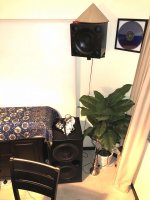
They sound really great, I have settled with a double reflex using BMS 12s330 and active amplification with bluetooth connection for convenience sake when listening and working with my laptop... The amplifier has two speakon outputs so its all build into the sub making one tidy setup.

Can you please provide information about your 8CX21 enclosure.
From previous posts it looks like the internal dimensions are 30cm x 30cm x 19.3cm and each of the 4 curved ports are 50mm diameter and 230mm long.
Can you please confirm as I would like to make this enclosure for my 8CX21.
From previous posts it looks like the internal dimensions are 30cm x 30cm x 19.3cm and each of the 4 curved ports are 50mm diameter and 230mm long.
Can you please confirm as I would like to make this enclosure for my 8CX21.
- Home
- Loudspeakers
- Full Range
- B&C 8CX21 Box Design

